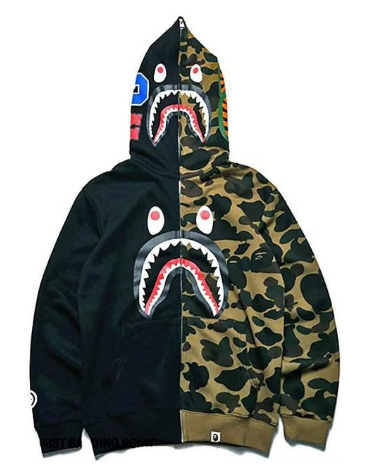The Impact of BAPE Hoodies on Streetwear Culture
BAPE, or A Bathing Ape, is a Japanese streetwear brand founded by Nigo (Tomoaki Nagao) in 1993. Renowned for its distinctive designs and vibrant color palettes, BAPE quickly became a cornerstone of streetwear culture, particularly in the early 2000s. One of the brand’s most iconic products is the BAPE hoodie, which has transcended mere fashion to become a symbol of status, individuality, and a lifestyle choice. This essay will explore the impact of BAPE hoodies on streetwear culture, examining their history, design, cultural significance, and lasting legacy.
Origins and Evolution
The inception of BAPE coincided with the rise of streetwear as a cultural movement. In the 1990s, streetwear was largely influenced by hip-hop, skate culture, and the burgeoning youth subcultures that embraced individuality and self-expression. Nigo, inspired by American hip-hop culture and the aesthetics of the 1980s and 1990s, aimed to create a brand that resonated with the youth of Tokyo and beyond. The BAPE hoodie, particularly the Shark Hoodie, emerged as a defining piece in the brand’s collection, featuring a unique graphic design with a hood resembling a shark’s mouth. This playful yet edgy design appealed to a generation seeking to differentiate themselves from mainstream fashion.
Design and Aesthetic
BAPE hoodies are characterized by bold graphics, camo patterns, and a playful yet rebellious aesthetic. The Shark Hoodie, which features a large shark graphic on the hood and often incorporates vibrant colors and patterns, has become particularly iconic. The design represents a fusion of street culture and high fashion, blurring the lines between casual wear and luxury.
Additionally, the use of limited-edition releases and collaborations with other high-profile brands and artists has solidified BAPE’s status as a collector’s item. The exclusivity of certain designs fosters a sense of community among wearers, creating a subculture that thrives on rarity and uniqueness. This phenomenon has led to the emergence of a resale market, where BAPE hoodies can fetch exorbitant prices, further emphasizing their value within the streetwear hierarchy.
Cultural Significance
BAPE hoodies have transcended fashion, becoming symbols of cultural identity and belonging. They are often associated with hip-hop artists and celebrities, further propelling their popularity and desirability. Artists like Pharrell Williams, Lil Wayne, and Kanye West have been spotted wearing BAPE, cementing its status as a staple in celebrity wardrobes. This visibility in popular culture has contributed to the brand’s global appeal, drawing in fans from various backgrounds and geographical locations.
Moreover, the rise of social media platforms, especially Instagram and TikTok, has allowed BAPE hoodies to gain even more traction. Influencers and fashion enthusiasts showcase their unique styles and outfits featuring BAPE gear, creating an aspirational image for younger audiences. This online presence has facilitated a new generation’s connection to the brand, allowing it to remain relevant and appealing to a younger demographic.
The BAPE Community
BAPE hoodies also foster a sense of community among wearers. The culture surrounding BAPE is not merely about clothing; it encompasses a lifestyle that values creativity, self-expression, and camaraderie. Fans often participate in online forums and social media groups where they share styling tips, trade pieces, and discuss upcoming releases. This interconnectedness amplifies the brand’s cultural impact, as enthusiasts collectively celebrate their love for BAPE.
Furthermore, the brand’s limited releases and collaborations create a sense of anticipation and excitement within the community. Events like pop-up shops and exclusive launches draw in large crowds, where fans can bond over their shared passion for streetwear. This communal experience solidifies the connection between BAPE and its wearers, creating a culture of loyalty and brand advocacy.
Lasting Legacy
The impact of BAPE hoodies on streetwear culture is undeniable. As streetwear continues to evolve, BAPE remains a significant player in the landscape, influencing new generations of designers and brands. The hoodie has become a canvas for artistic expression, with various artists and designers interpreting the iconic BAPE aesthetic in their own unique ways.
Moreover, the blending of high fashion and streetwear, exemplified by BAPE, has reshaped the fashion industry. Major luxury brands now recognize the influence of streetwear and have begun to incorporate elements of this culture into their collections. BAPE’s success has paved the way for other streetwear brands, demonstrating that fashion can be both accessible and aspirational.
Conclusion
In conclusion, Bape Jacket have made a profound impact on streetwear culture, shaping not only fashion but also identity and community. Their distinctive designs, cultural significance, and lasting legacy have solidified their place in the annals of fashion history. As streetwear continues to grow and evolve, BAPE remains a beacon of creativity, individuality, and self-expression, inspiring future generations to embrace their unique styles and identities. The BAPE hoodie is not just a piece of clothing; it is a cultural artifact that embodies the spirit of streetwear and the voices of those who wear it.








